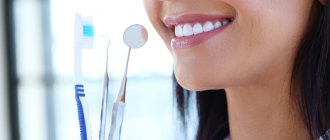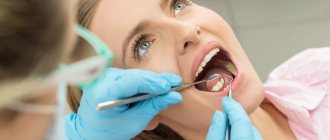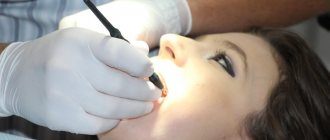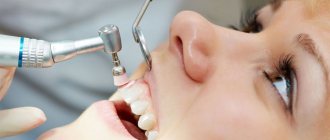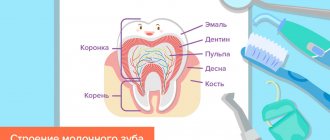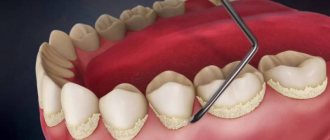Date of publication: 09/29/2018
Plaque is the worst enemy to oral health. It is he, or rather, the microbes that develop in him, that provoke the development of caries. The soft plaque becomes hard over time, turning into tartar.
It is the leading cause of gingivitis, periodontitis, gum pockets, and even tooth loss.
Plaque removal is necessary to keep teeth and gums healthy.
Why do you need to brush your teeth?
Oral hygiene is not only a matter of aesthetics. It is due to medical reasons. A plaque constantly forms on the enamel, consisting of: • food particles; • saliva; • waste products of microorganisms inhabiting the oral cavity.
The process of plaque deposition does not depend on whether a person ate in the interval between brushings. If it is not removed, over time it turns to stone. Contamination not only creates a cosmetic defect. Deposits contribute to the violation of the integrity of the enamel. Pathogenic bacteria penetrate into the resulting cracks and actively multiply under conditions of poor hygiene. This is how caries begins with all the known consequences. These microorganisms also attack the gums. In people who neglect to brush their teeth, gingivitis becomes chronic. If the inflammation is not treated, complications in the form of periodontitis and periodontal disease are possible. As a result, the root no longer holds in the socket and the tooth falls out.
Why is dental plaque dangerous?
Bacteria attached to the surface of the teeth produce acids as a result of their vital activity. These substances have a detrimental effect on the enamel, causing its damage and further development of caries. Hard deposits also affect soft tissues, as they are located mainly in the cervical area and provoke inflammation of the gums. If the situation is not corrected, gingivitis and deeper forms of gum inflammation develop over time.
How to brush your teeth correctly?
It is a mistaken idea that everyone can do this. There are a number of rules, many of which are either unknown or ignored. However, only compliance with them guarantees effective cleaning of the enamel: • Carrying out hygiene procedures not only at home, but also at the dentist. • Rational selection of brushes and paste. • Using the optimal teeth brushing method. • Using dental floss, brushes and mouthwash. • Taking into account the condition of the gums, the presence of braces and dentures. • Compliance with the rules for storing, cleaning and replacing brushes.
Tablets for determining plaque will help you understand whether you have achieved your goal. They demonstrate whether unwanted deposits are present on the enamel. They also suggest which areas are not being worked through carefully enough.
Types of oral hygiene
To maintain the microflora of the oral cavity, in which the teeth and oral mucosa will always be healthy and aesthetically pleasing, there are a number of hygiene measures. They are divided into two main types: personal hygiene and professional procedures.
In the first case, oral care is carried out independently at home. According to the recommendations of dentists, the procedure should begin at an early age, when children have their first teeth.
If cleaning the mouth at home does not bring the desired result, the second method is used. Professional cleaning is carried out in a medical institution by a dentist.
Each method requires compliance with a number of rules. Therefore, in order for the procedures to be highly effective, it is necessary to familiarize yourself with them in more detail.
Choosing a toothbrush
To completely clean the enamel from plaque, you need to choose a suitable brush. The easiest way to do this is by material. There are two options here - natural and synthetic. It is better to give preference to the latter, since they are quite elastic, and the tips of the hairs are usually rounded, which is safer for the gums. Bacteria multiply faster on natural materials.
In terms of the stiffness of the bristles, toothbrushes are: • Soft. They are best taken for children, adolescents and people suffering from gingivitis. • Average. A universal option for people without dental problems. • Tough. They help fight hard plaque and can be used only when indicated.
The configuration of the bristles should be discussed with your dentist. It will tell you where more sediment collects. For example, if you need to better work on the necks of teeth, bristles collected in bunches can handle this.
Pasta selection
Pastes are hygienic, preventive and therapeutic. The first ones solve the only problem - clean the enamel. The latter, due to the antiseptic component, help prevent the development of gingivitis and caries. Still others are prescribed by dentists for therapeutic purposes; it is better not to use them on your own.
Toothpastes are also distinguished according to the results of use: • whitening - slightly lighten the enamel, but you should not expect drastic changes from them; • strengthening – contain fluoride, good for enamel health; • desensitizing - reduce sensitivity; • anti-inflammatory - help with gingivitis.
Abrasiveness characterizes the degree of impact on plaque. The average value of this indicator is from 50 to 80. Higher values can be taken occasionally to lighten teeth. Lower abrasiveness is indicated for sensitive enamel and gums.
Buy an irrigator for cleaning teeth
Before purchasing a device for cleaning teeth and gums, or an irrigator, we recommend reading and comparing customer reviews about the purchased models. Also on our website you can select and compare various models of irrigators in the catalog. The cost of such a design depends on its functionality and additional options, as well as on the status of a particular manufacturer. In our catalog you can study the cost of Waterpik irrigators from the Arcom company. You can purchase such a device for several thousand rubles, and it will last for a long time, so every buyer can afford a high-quality device, regardless of their level of material income.
Proper brushing of teeth: sequence of movements
For hygiene purposes, you need to accustom yourself to a certain sequence of movements.
After squeezing the paste onto the brush, you must: • apply it to the teeth at an angle of 45 or 90 degrees; • pass each one 3-4 times in the direction from the gums to the cutting edge; • treat chewing surfaces with circular movements; • Allow at least 30 seconds of brushing for each half of the jaw. Depending on the location of the brush and the direction of movement, there are three methods of brushing teeth. The most famous (90 degree brush, top to bottom movements) is the Leonard method.
The Bass method involves choosing an angle of 45 degrees and making vibrating movements. It is good because the bristles penetrate into the interdental spaces and partially work out the contact surfaces. With the Fones method, an angle of 90 degrees is taken and the brush moves in a circle. This further massages the gums, which improves blood circulation and protects against inflammatory processes.
Irrigator Waterpik (Waterpik) –
Waterpick irrigators are developed (USA) and it is one of the most famous brands of irrigators in the world. However, the assembly of the devices is carried out in China. The manufacturer offers a fairly wide range of stationary models, but they all have similar characteristics. The characteristic of the water jet is a monojet with 1400 pulsations per minute, the water pressure is adjustable from 70 to 550-690 kPa (depending on the model). Unfortunately, microbubble technology is not used in Waterpik irrigators.
The flagship model is the Waterpik WP-100 EU Ultra irrigator, the price of which will be about 6,500 rubles. The most expensive model “Waterpik WP-660 EU Ultra Professional” will cost about 8,000 rubles (this model is distinguished by the presence of a second “gum massage” mode, as well as a wider selection of water pressure levels). The model that has the minimum cost is “Waterpik WP-70 EU Classic” from 4,500 rubles, which has fewer nozzles included + only 5 levels of water pressure adjustment.
Examples of Waterpik irrigators and attachments for them -
Let me summarize the pros and cons of Waterpik - 1) these are high-quality devices whose water pressure corresponds to the declared one, 2) a 2-year guarantee, which also confirms the reliability of these devices, 3) a very wide range of attachments for all cases - including periodontal ones for the care of gum pockets, attachment for braces, attachment for bridges, etc.
Disadvantages - the lack of microbubble technology, as well as the lack of a network of service centers in Russia (i.e. if a breakdown occurs during the warranty period, you will have to send the irrigator to Moscow at your own expense, and after some time they will simply send you a new device) . If the breakdown occurs after the expiration of the warranty period, then service is not possible and you will only have to throw away your device, because Apart from replacing attachments and batteries, the devices cannot be repaired.
Additional oral cleansing
Oral hygiene is not limited to two rows of teeth. For complete cleansing it is necessary to treat: • Interdental spaces. Dental floss or a brush will help remove plaque. • Language. To do this, use the relief surface of the back of the toothbrush or a special scraper. • Gums. They are partly cleaned with a brush: at an angle of 45 degrees, the bristles approach the edge and capture deposits. Rinse aid also helps. • Cheeks. You can go over them with the back of the brush, but they require more rinsing.
You need to start by removing the largest food debris. To do this, just rinse your mouth with water. Then comes the turn of fragments stuck in the interdental spaces - this is where floss comes to the rescue. Now you can take up the brush with the paste. Rinse aid is used last - to create a protective layer.
Recommendations for oral hygiene
In medical practice, there are certain rules for the technique of cleaning the mouth. Compliance with them does not require much effort or difficulty.
Oral hygiene recommendations from experts:
- To maintain the microflora in the mouth and the strength of the teeth, it is necessary to follow a balanced diet of dairy and legumes.
- To brush your teeth, it is better to choose a brush with synthetic bristles.
- The cleaning attribute should be replaced every 3-4 months.
- Clean your mouth with a toothbrush and toothpaste 2 times a day. The first procedure is carried out in the morning, the second before bedtime.
- Various oral hygiene practices should include cleaning the tongue and gums. This will be a good means of preventing periodontal disease.
- After each procedure, the toothbrush must be thoroughly rinsed with running water.
- It is recommended to clean the spaces between teeth after every meal. To do this, you can use dental floss or special wooden sticks.
- It is better to entrust the monitoring of the condition of the oral cavity to the dentist.
- Professional hygiene should be carried out 1-2 times a year by a qualified specialist.
- For hard-to-reach areas of the mouth, it is advisable to purchase specialized tools, such as a brush and floss.
- Don't neglect mouthwashes either. Their regular use contributes not only to fresh breath, but also to the strength of the enamel structure.
It is recommended to explain the rules of oral care to a child from an early age. In this case, the cleaning procedure will become an integral part of a person’s life, which will significantly reduce the risk of pathologies in the oral cavity.
How to brush your teeth with gingivitis?
Inflammation of soft tissues is not a reason to neglect hygiene. On the contrary, the more often cleansing is done, the less chance bacteria have to support the inflammatory process.
However, you need to take precautions: • choose brushes with soft bristles (preferably rounded); • choose a paste with low abrasiveness and containing medicinal herbs; • give preference to the Bass method, and abstain from the Fones method until remission; • move your hand more carefully to avoid painful sensations.
Cleaning time should not be shortened, even if the procedure causes discomfort. Sometimes dentists even recommend increasing it. Inflammation of the gums is accompanied by the formation of pockets. Where their edges lag behind, stone grows with particular intensity. This place deserves more careful study.
How to clean dental structures?
Dental structures in the mouth make adjustments to the cleaning process: • Crowns. More attention should be paid to the area where the gums come into contact with the prosthesis. • Bridges. A round mono-tuft brush is more suitable for them. • Veneers. The teeth where they are installed cannot be treated with floss. The ban does not apply to other methods. • Braces. The space under the arch and the area adjacent to the enamel is cleaned with brushes.
In all of the above cases, it is necessary to use an irrigator. Conventional cleaning devices are not able to penetrate all the places where plaque accumulates. There are no barriers for water. Under the pressure set by the device, it knocks out stuck food fragments, preventing them from decomposing or turning into stone.
Advantages of the irrigator
A good irrigator is ideal for removing food debris in places that a regular toothbrush cannot reach:
- in various hard-to-reach areas;
- in the spaces between the teeth;
- under orthopedic type structures;
- for orthodontic devices.
The main advantage of an oral irrigator is the ability to thoroughly clean the teeth from plaque without damaging the gums (as often happens when using a regular brush). In addition, the liquid under pressure produces a massaging effect on the gums and improves blood circulation.
As for the effectiveness of the irrigator, it directly depends on proper use. Today, devices are produced by many manufacturers; the devices differ in a similar principle of operation.
How do plaque tablets work?
We usually contact a dentist to assess the quality of oral hygiene. It identifies areas that are not cleaned effectively and makes recommendations for replacing the paste or brush. But in between visits to the clinic, you can cope without the help of a doctor.
Special tablets, developed by the Swiss company CURADEN, will help with this. They are part of the CURAPROX range of dental care products. Determination of plaque occurs as follows: • the tablet is diluted in water; • after brushing, a person rinses his mouth with this solution, distributing it over his teeth; • deposits are stained, clean enamel remains intact.
The tablets also help distinguish soft plaque from tartar. The first one becomes pink, the second one becomes dark blue. This way you can understand whether it’s time to go for ultrasonic cleaning.
Why does plaque appear?
Soft plaque on teeth is normal. Its formation is associated not only with food intake, but also with natural processes in the oral cavity and the characteristics of the microflora. Food debris and various bacteria attach to the natural thin layer of plaque. If this layer is regularly cleaned, it does not cause any harm and is an integral part of the body's functioning.
Soft plaque can be deposited on teeth for a number of reasons:
- Insufficient oral hygiene.
- Lack of solid food that can mechanically clean teeth when chewed.
- Malocclusion, crowded teeth. For this reason, it is impossible to remove plaque in some places with a toothbrush.
- A metabolic disorder that provokes changes in the microflora of the oral cavity and accelerated plaque formation.
- Taking certain medications.
- Periodontitis and other inflammatory processes.
Hard plaque, or tartar, forms when soft plaque is not cleaned thoroughly enough. Mineralization is responsible for this process, turning soft deposits into stone.
Consequences of not brushing your teeth properly
Proper and timely cleaning of dental plaque is protection against oral diseases.
If you neglect it, the consequences will only increase: • Tartar forms. It gives off an unpleasant odor. If you do not carry out ultrasonic cleaning, it will become a favorite place for bacteria. • Bacteria will destroy the enamel. The abundance of pathogenic microorganisms quickly leads to caries. • Bacteria will cause your gums to become inflamed. Soft tissues are no less sensitive to them than hard ones. And this means bleeding, swelling and an unpleasant odor.
Possible complications are also worth mentioning. Caries develops into pulpitis, which requires removal of the nerve. This deprives the tooth of nutrition, as a result of which it sooner or later collapses. Progressive gingivitis is fraught with periodontitis and periodontal disease. Lack of oral hygiene leads to tooth loss. Restoring them is more expensive than the cost of a brush, paste and professional cleaning. Therefore, it is better to remember these simple rules and follow them.
Why is daily teeth brushing required?
Our mouths are home to millions of all kinds of bacteria, the number of which increases after eating. Microscopic food particles stuck in the teeth become a breeding ground for the development of microorganisms that rapidly multiply if you do not brush your teeth. This contributes to the formation of soft plaque, which produces acid that destroys tooth enamel.
Note! By regularly getting rid of this plaque, we prevent the growth of bacteria, the formation of tartar, prevent the development of caries and the appearance of an unpleasant odor in the mouth. Professional office hygiene AirFlow removes plaque well Performed by a hygienist, dentist or orthodontist.
Tips for choosing toothpaste
When buying a paste, you should pay attention to its composition, which includes a number of additional active substances. Each type of paste promotes a specific therapeutic and prophylactic effect: treats excessive sensitivity, strengthens enamel, whitens, prevents caries, replenishes deficiencies of microelements, etc.
In addition to the content of additives, the appearance and consistency of the paste are taken into account. Opaque cream formulations contain calcium elements, which provides a great cleansing effect. They need to be used in the morning. Gel pastes and balms contain substances with the help of which a special film is formed on the surface of the teeth, preserving useful elements inside. Such pastes have medicinal properties and are recommended for evening use.
Note! To avoid addiction, toothpaste and brush should be changed periodically to enhance the effectiveness of the therapeutic and prophylactic components.
How many times a day should you brush your teeth?
Brushing your teeth should become a habit from childhood. You need to carry out this procedure at least twice a day - in the morning, after you have breakfast, and at the end of the day before going to bed. During the period of correcting the bite with braces, it is necessary to brush your teeth after every meal.
Only the surface of the teeth is cleaned with a brush, and it is recommended to use dental floss for the interdental spaces. Carefully, so as not to damage the gums, the floss is inserted between the teeth, removing food particles and plaque. It is also useful and safe to use an irrigator. A strong pulsating stream of water will carefully clean all interdental spaces from food debris.
Each cleaning should end with rinsing using special ready-made products or self-prepared herbal decoctions. Additionally, rinsing after every meal is a good and healthy habit.




